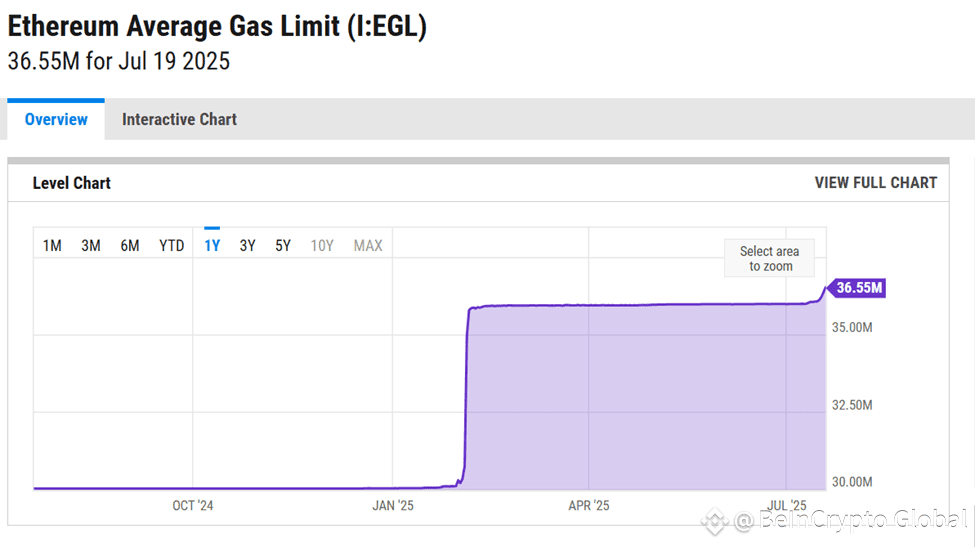Ethereum’s gas limit is rising, with core developers and stakers pushing the network’s capacity boundaries.
Despite the network moving toward higher throughput and leveraging stronger infrastructure, some remain cautious about potential risks.
Ethereum gas Limit Increases to 37.3 Million
On July 20, Ethereum co-founder Vitalik Buterin confirmed that the Layer 1(L1) gas limit had already increased to 37.3 million. Further, almost exactly 50% of the stake supports a further rise to 45 million.
The gas limit determines the maximum computational effort that can be included in a single Ethereum block.
Raising this threshold effectively increases the network’s throughput, allowing it to process more transactions and complex operations per block.
 Ethereum Gas Limit as of July 19. Source: YCharts
Ethereum Gas Limit as of July 19. Source: YCharts
However, such changes also introduce higher demands on node operators, an issue that has historically sparked concerns around decentralization, safety, and fees.
“Do you think this is a solution to end the gas fee issues in the long term, or will we see gas prices rise again later due to transaction pressure?” one user posed.
Addressing these concerns, Buterin linked the current push to raise gas limits with recent advances in Ethereum’s client infrastructure. The crypto executive referenced Go Ethereum’s (Geth) latest software release.
Geth v1.16.0, launched on June 27, is a major milestone in client efficiency. It introduces a new path-based archive mode, drastically reducing the disk space required for archive nodes from over 20 terabytes to around 1.9 terabytes.
Ethereum developer Marius Van Der Wijden recently explained that the new setup allows users to query historical blockchain states more efficiently. This is an essential feature for validators, researchers, and dApp developers alike.
“Geth v.1.16.0 finally ships the PBSS based archive node, you can have a geth archive node in ca. 1.9TB (down from 20+TB). Queries against historical states (What was my balance at block X) are possible, proofs against historical states are not (yet),” wrote Wijden.
The archive node optimization enhances Ethereum’s scalability while making the network more accessible to independent node operators.
With this, it preserves decentralization and enables higher throughput. Notwithstanding, not everyone is convinced.
“Is this scaling or are we just turning the stove up and hoping it doesn’t burn the kitchen?” another user challenged.
Buterin also articulated that this was scaling, adding that client developers and researchers were already working to enhance resilience.
This metaphor reinforces the broader message that Ethereum’s scaling goes beyond pushing limits. Rather, it is about thoughtful engineering backed by years of client-side improvements.
Meanwhile, these strides come as Ethereum grows post-Dencun upgrade, preparing for further enhancements under the Pectra roadmap.
Increasing the gas limit appears part of a broader effort to unlock higher throughput without compromising the network’s stability.
With half the stake already backing the move to 45 million, Ethereum’s next scaling milestone may be imminent.

